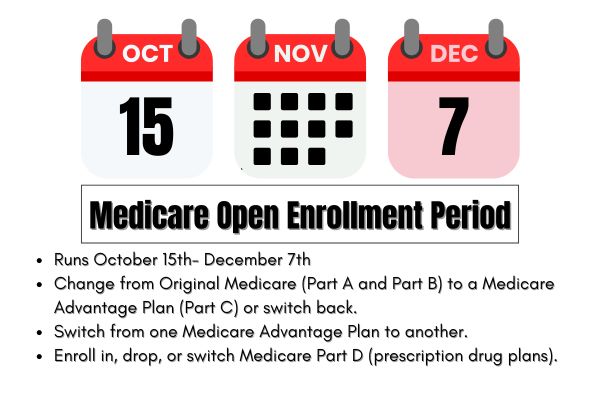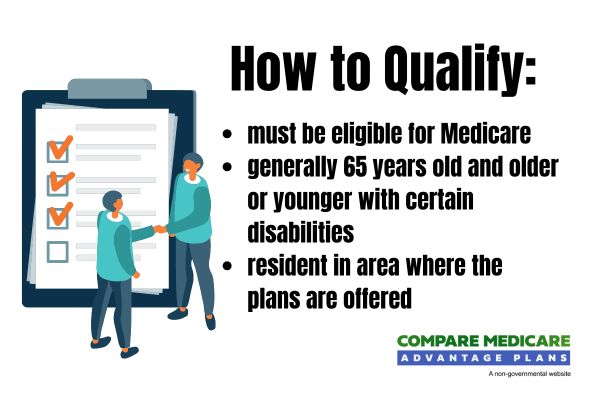




Medicare Advantage Plans North Dakota 2026
Want to know more about the Medicare Advantage Plans in North Dakota
Key Takeaways
- North Dakota Medicare Advantage Plans will likely offer comprehensive coverage under private companies, sometimes offering additional benefits like vision and dental care.
- Available plan types include HMO, PPO, and Special Needs Plans (SNPs), each with unique features and potential benefits, emphasizing the importance of understanding individual healthcare needs before choosing a plan.
- Enrollment for Medicare Advantage Plans requires individuals to have Medicare Part A and B, with key enrollment periods occurring annually, highlighting the need for timely decision-making.
Compare Plans in One Step!
Enter Zip Code
Understanding North Dakota Medicare Advantage Plans 2026

Medicare Advantage Plans in North Dakota will likely offer comprehensive healthcare coverage through private companies that contract with the federal government. These plans include both Part A (hospital) and Part B (outpatient) services, possibly ensuring a broad spectrum of medical care. Unlike Original Medicare, which directly pays for services, some plans might offer a maximum out-of-pocket limit, potentially providing financial protection once this limit is reached. Enrollment requires individuals to reside within the service area of the chosen plan and have both Medicare Part A and Part B.
Medicare Advantage Plans may be particularly attractive due to the potential benefits certain plans may provide. Beyond standard Medicare coverage, some plans may include services such as vision, dental, and hearing coverage.
Types of North Dakota Medicare Advantage Plans Available

North Dakota will likely offer a variety of Medicare Advantage Plans to cater to different healthcare needs and preferences. The primary types available are Health Maintenance Organizations (HMO), Preferred Provider Organizations (PPO), and Special Needs Plans (SNPs). Each type could offer distinct features and benefits, making it important to understand their differences to choose the most suitable plan for your healthcare requirements.
HMO Plans
HMO (Health Maintenance Organization) plans in North Dakota require members to use a network of local healthcare providers for non-emergency services. Members must choose a primary care physician to coordinate their care and provide referrals to specialists as needed.
These Plans may offer lower premiums compared to other Medicare Advantage Plans but might limit coverage to in-network doctors and hospitals. Despite these potential restrictions, HMO plans generally cover all Medicare services and may offer additional benefits like vision and dental care.
Enrollment options may vary by location, with some areas offering more plan choices.
PPO Plans
PPO (Preferred Provider Organization) plans offer greater flexibility, allowing members to receive care from both in-network and out-of-network providers, though out-of-network care might come at a higher cost.
Special Needs Plans (SNPs)
Special Needs Plans (SNPs) cater to specific groups such as individuals with chronic conditions or those eligible for both Medicare and Medicaid. North Dakota will likely offer Dual Special Needs Plans (D-SNPs) for individuals eligible for both Medicare and Medicaid.
These plans provide coordinated care by integrating Medicare and Medicaid services under one plan, possibly offering additional benefits like vision, dental, and hearing services. D-SNPs could potentially ensure that tailored care for dual-eligible individuals.
Overview of North Dakota Medicare Advantage Plans 2026
Medicare Advantage Plans in North Dakota are offered by several private insurance companies, likely providing extensive healthcare coverage options. These plans include both Part A (hospital) and Part B (outpatient) services.
These plans may offer various copayments, coinsurance, and deductibles, sometimes including a maximum out-of-pocket limit to protect beneficiaries from excessive healthcare expenses. Some plans may also include additional benefits that could go beyond what Original Medicare covers, possibly adding value for members within the plan’s designated service area.
Enrollment requires individuals to have both Medicare Part A and Part B.
Possible Services and Benefits
Some Medicare Advantage Plans in North Dakota may offer a wide range of services and benefits that could go beyond Original Medicare. Certain plans might include dental, vision, and hearing coverage. Prescription drug coverage may also be covered in certain plans, possibly offering coverage for a variety of brand name and generic medications.
These additional benefits could potentially enhance the quality of life for those enrolled in Medicare Advantage Plans.
Enrollment Process for North Dakota Medicare Advantage Plans 2026
Enrolling in a Medicare Advantage Plan in North Dakota involves several steps to ensure you receive the healthcare coverage you need. These plans are offered through private companies that partner with the federal government to deliver Medicare benefits. Eligibility requires individuals to be enrolled in both Medicare Part A and Part B. Understanding the enrollment process is essential to avoid lapses in coverage and take full advantage of the benefits offered by these plans.
The main enrollment period for Medicare Advantage Plans typically runs from October 15 to December 7 each year, allowing individuals to enroll or make changes to their plans. For those whose plans are being discontinued, a Special Enrollment Period is available from December 8 to February 28 each year.
It’s crucial to complete enrollment by December 31 to ensure coverage begins in January the following year. Understanding these timelines can help in planning and choosing the best Medicare Advantage Plan for your needs.
When to Enroll

The primary enrollment period for North Dakota Medicare Advantage Plans is from October 15 to December 7 each year, known as the Annual Enrollment Period (AEP). This period allows individuals to choose or switch plans.
If your current plan is discontinued, a Special Enrollment Period runs from December 8 to February 28, allowing you to select a new plan. Complete enrollment by December 31 to ensure continuous coverage into the new year.
Different Enrollment Periods
There are multiple enrollment periods throughout the year for Medicare Advantage Plans. The Initial Enrollment Period (IEP) spans seven months, starting three months before an individual turns 65, including their birthday month, and ending three months afterward.
The Annual Enrollment Period (AEP) runs from October 15 to December 7, allowing individuals to make changes to their plans for the upcoming plan year. The Open Enrollment Period (OEP) from January 1 to March 31 allows beneficiaries to switch plans or revert to Original Medicare.
Special Enrollment Periods (SEPs) are available for those who experience significant life changes, such as losing employer-based coverage.
OEP, AEP, and Special Enrollment
The Open Enrollment Period (OEP) for Medicare Advantage Plans runs from January 1 to March 31 each year, allowing beneficiaries to make changes to their plans. The Annual Enrollment Period (AEP) from October 15 to December 7 is the main period for enrolling or switching plans.
Special Enrollment Periods (SEPs) provide opportunities to enroll or change plans due to specific life events, such as moving out of the plan’s service area or losing other health coverage. Understanding these enrollment periods ensures timely and informed decisions about healthcare coverage.
Possible Costs Associated with North Dakota Medicare Advantage Plans 2026
The potential costs associated with North Dakota Medicare Advantage Plans
Premiums and Co-Pays
Beneficiaries of Medicare Advantage Plans may need to pay a monthly premium in addition to the regular Part B premium. Premiums for Medicare Advantage Plans in North Dakota may vary depending on the specific plan.
Certain plans may also involve cost-sharing through copayments and coinsurance for various healthcare services. Some plans may also offer a maximum out-of-pocket limit, possibly ensuring that members could be protected from excessive annual healthcare costs.
Out-of-Pocket Maximums
Some Medicare Advantage Plans in North Dakota might feature a defined out-of-pocket maximum, possibly ensuring that beneficiaries are not overwhelmed by healthcare costs. This potential cap could provide financial predictability and protection for members. The out-of-pocket maximum may vary by plan, likely impacting the overall affordability of healthcare services.
Members should review the specific details of each plan to understand how these limits could affect their total healthcare expenses.
Potential Services and Benefits
Certain Medicare Advantage Plans in North Dakota may offer an array of covered services and benefits that might extend beyond those provided by Original Medicare. Some plans may integrate prescription drug coverage, possibly ensuring that members have access to necessary medications and treatments. Certain plans may also cover dental, vision, and hearing services, possibly catering to a wider range of health needs.
These comprehensive benefits could make Medicare Advantage Plans an attractive option for those seeking extensive healthcare coverage.
How to Qualify for North Dakota Medicare Advantage Plans 2026

To qualify for Medicare Advantage Plans in North Dakota, individuals must be enrolled in both Medicare Part A and Part B. Additionally, applicants must reside within the service area of the plan they wish to enroll in. Some plans may require a monthly premium in addition to the Medicare Part B premium.
Members should also verify whether healthcare providers accept the terms of the selected plan. Some Medicare Advantage Plans might offer additional benefits that could go beyond those provided by Original Medicare, possibly making them a valuable option for eligible individuals.
Contracted Network and Access to Care
Medicare Advantage Plans in North Dakota feature a contracted network that will likely include various healthcare providers, possibly allowing members to access both in-network and out-of-network care, though out-of-network visits may incur higher costs. Members of PPO plans may consult specialists without needing referrals, likely offering flexibility in choosing any provider who accepts Medicare.
HMO plans, however, usually require members to have a primary care provider who coordinates their care. Emergency services are covered worldwide, ensuring access to urgent care even outside the contracted network.
Comparing North Dakota Medicare Advantage Plans to Original Medicare
Some Medicare Advantage Plans in North Dakota may offer several advantages over Original Medicare. These plans are managed by private companies that have agreements with Medicare to provide benefits directly to enrollees, covering both Part A and Part B services.
Unlike Original Medicare, certain Medicare Advantage Plans may offer additional benefits such as dental and vision coverage, possibly making them a more comprehensive healthcare option.
Coverage Differences
While Medicare Advantage Plans must cover all the benefits that Medicare offers, some plans may provide additional services not included in Original Medicare, such as dental, vision, and hearing services.
Cost Comparisons
Medicare Advantage Plans may have cost-sharing structures that might include copayments, coinsurance, and deductibles, along with a maximum out-of-pocket limit for yearly expenses. In contrast, Original Medicare has standardized costs like deductibles and coinsurance but lacks an annual spending cap, which could lead to higher out-of-pocket expenses.
Medicare Advantage Plans could potentially offer lower monthly premiums, possibly making them a cost-effective alternative to Original Medicare.
Emergencies and Referrals

During a declared public health emergency, Medicare Advantage Plans may allow members to receive in-network costs for out-of-network facilities, possibly ensuring access to necessary care. In emergencies, members may also be exempt from referral requirements, possibly facilitating quicker access to medical services.
Summary
Navigating the potential Medicare Advantage Plans in North Dakota
Frequently Asked Questions
→ When can I enroll in a Medicare Advantage Plan in North Dakota?
You can enroll in a Medicare Advantage Plan in North Dakota during the main enrollment period from October 15 to December 7 each year, as well as during special enrollment periods for qualifying life events.
→ What additional benefits could Medicare Advantage Plans offer?
Some Medicare Advantage Plans may offer additional benefits such as dental, vision, and hearing, which are not included in Original Medicare. These potential benefits might make these plans a compelling choice for comprehensive healthcare coverage.
→ What are the potential costs associated with Medicare Advantage Plans?
Medicare Advantage Plans might involve various monthly premiums, copayments, coinsurance, deductibles, and out-of-pocket maximums. It’s essential to review these costs to choose a plan that fits your financial situation.
→ How do I qualify for a Medicare Advantage Plan?
To qualify for a Medicare Advantage Plan, you need to be enrolled in both Medicare Part A and Part B and live within the plan’s service area. Ensure you meet these criteria to proceed with your enrollment.

ZRN Health & Financial Services, LLC, a Texas limited liability company





